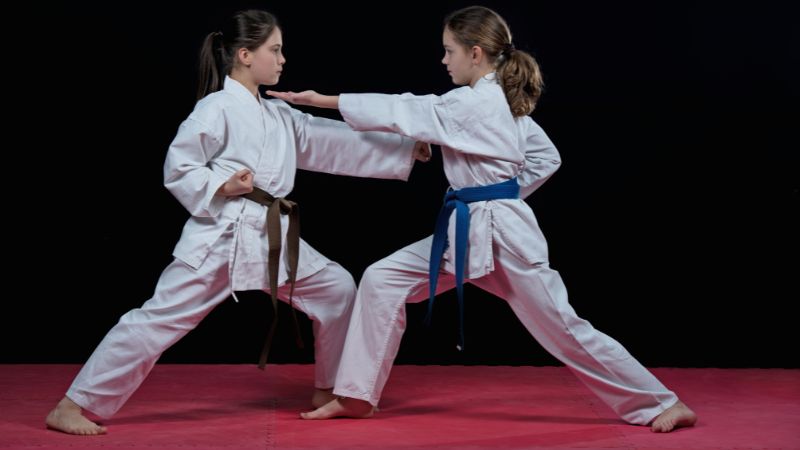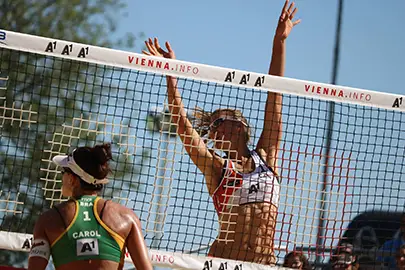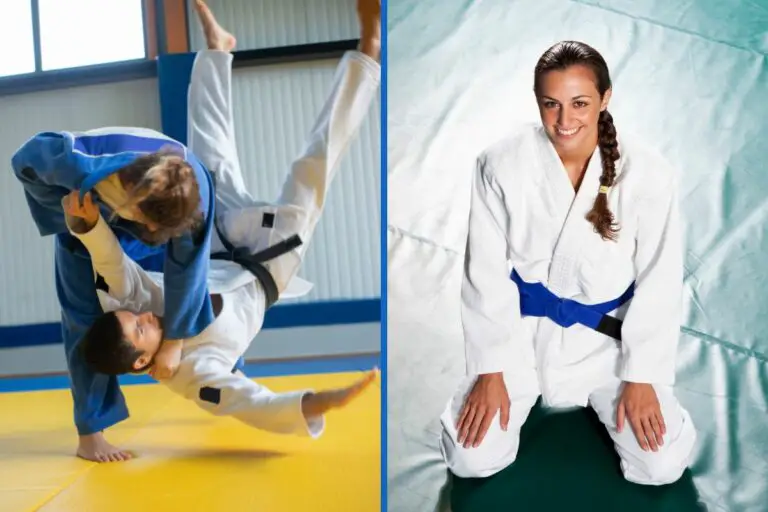What’s the Difference between Judo and Karate?
If you don’t practice or follow these sports, karate and judo might seem similar. You see these guys wearing a kimono and fighting on a tatami. But it’s the only common points between these two sports, there are many differences between karate and judo.
The main difference is that judo is a defensive martial art, while karate is an attacking and aggressive martial art. In karate, kicks are allowed, not in judo. And judo often happens on the ground, while it’s extremely rare in karate.
If you want to know more, I’ll explain these martial arts origins, their philosophy and the other major differences in fight and equipment.
Karate
Definition
A Japanese art of self-defense employing hand strikes and kicks to disable or subdue an opponent
Merriam-Webster
The main thing to remember in this definition, is that in karate, fighters give kicks.
You should also know that kicks are generally stopped before touching the opponent (or even if hit, the goal is to not hurt).
In fact, it’s the sense of the word: karate = kara (empty) + te (hand).
Origins
Karate was created in China, but Japan brought many improvements, so it’s really a Japanese martial art.
Gichin Funakoshi is often referred to as the karate inventor, even though karate existed long before.
Important facts
World Karate Federation: Created in 1970, the world federation now includes 190 countries for over 100 billion practitioners over the world.
Olympic Games: Long after other sports like judo and taekwondo, karate will participate in the 2020 summer Olympic Games for the first time (in Japan, Tokyo for the fun story).
World championship: Japan, France and Great Britain are the best nations of all time in the karate world championships. I’ll show you a video from the 2018 edition later in this post.
Equipment
The basic material to do karate is simple: a kimono and a belt.

Like in judo, the belt color indicate the fighter experience (from white for beginners to black for experts, with intermediate colors: yellow, orange, green, blue and brown).
In the biggest competitions, the organizer gives a different color to each fighter, even if they both have a black belt normally. Generally, it’s blue and red belts. In this case, they were the belt color imposed by the organizer.
I told you the basic material, but it all depend on the situation.
Many accessories exist to protect the fighters, protections for hands, feet, teeth and intimate parts.
Kids often wear helmet and chest plate in addition to protect themselves.
Fights
Kumite and katas
You have to know that two types of fights exist in karate: classical fights (kumites) and katas.
I’ll go back to classic fights later.
But katas are a choreography, attempting to reproduce a fight, following a predefined plan, without a real opponent.
Here is an example in video, from the team final of the world championship in Paris (2018), if you want to know what it looks like:
How do karate fights work?
Now we can talk a little about classic fights in karate.
They last between one and three minutes, depending on the competitions.
Point counting may also differ in each competition.
Generally, the goal is to respect the championship rules.
There may be rules of precision, touch or respect of authorized targets.
A referee team watches the fight from the tatami, and award points according to these rules.
As in many other martial arts, there are penalties that make lose points.
So, great champions should also keep their cool to avoid them.
They can lose a fight just due to one penalty.
Demonstration video
To finish about karate, here is a video of a classic fight.
So, you can see everything I said resumed in one video:
Judo
Definition
A sport developed from jujitsu that emphasizes the use of quick movement and leverage to throw an opponent
Merriam-Webster
At the opposite of the karate martial art, the big thing to remember is that in judo there is no kick.
The main goal is to put your opponent on the ground, by using many catches.
The fight doesn’t necessarily end when one or both opponents are on the ground.
Origins
Judo was created in 1882, by Jigorō Kanō in Japan.
The goal was to transform jujitsu (classical combat sport), into a new discipline, integrating a big part about mind and body education.
Judo includes many important values, whose parents like a lot.
That’s why there are so many practitioners in the world (over 50 billions, five times more than karate).
Here are the values of judo:
- Politeness
- Courage
- Sincerity
- Honor
- Modesty
- Respect
- Self control
- Friendship
These values are more important than the technique in judo.
Respect and trust in the opponent are also essential to have the best fight possible.
Important facts
Currently, Japan, France and South Korea are the best countries in the world.
Ryoko Tani (Japan), Tadahiro Nomura (Japan) and David Douillet (France) are considered as the all-time best judokas in the world.
Material
The basic material of a judoka is also simple: kimono and belt as well
The judo kimono is a bit heavier / thicker than karate.
Belts are working the same way, a different color for each level, with black belt for the highest grades (first dan or more).

As there is no kick in judo, no protection material is required.
That does not mean you will not hurt yourself, I know what I’m talking about 🙂
Fights
There are also Katas in judo.
But there is no competition with katas to my knowledge.
Competitions are only for classic fights.
As in karate, athletes are classified by age, weight and gender.
There are also many similarities in the counting of points.
Without going in too many technical details, you can win points (advantages) or lose some (penalties) following your actions on the tatami.
Points are generally marked according to the result obtained in combat when the opponent is put on the ground (more or less points depending on how he falls).
It is also possible to score points on the ground by immobilizing the opponent.
Video
As for karate, here is a video of a fight between Riner and Moura in 2017:
Differences between Judo and Karate
In short, here are the 3 main differences between judo and karate:
- Different origins: Judo is born in Japan, while karate is a Chinese martial art.
- Strategy: Karate is an aggressive sport, using kicks to attack. Judo is a defensive martial art, with fight on the ground but no kicks.
- Equipment: Both use similar equipment (kimono and belt), but karate fighters wear protections.
| Judo | Karate |
|---|---|
| Kicks are forbidden. | Kicks are essentials. |
| Fight on the ground is essential. | There is no fight on the ground. |
| Created in 1882, in Japan. | Created in China. |
| No protection. | Many protections are worn by the fighters. |
Conclusion
That’s it, you know everything about judo and karate, or at least you know the main differences.
If you should remember only one thing, notice that karate uses kicks (with hand or foot) while judo only use catches.
If you liked this article, you can also read the difference between karate and kung-fu on this website.





